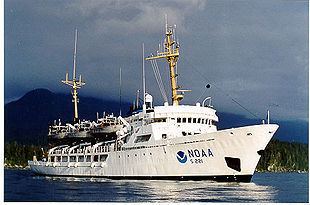Acquired April 1968 (delivered) Name NOAAS Rainier (S 221) Length 70 m Range 10.923096 million m Builder Jacksonville | Commissioned 2 October 1968 Launched March 1967 Weight 1,829 tons Endurance 22 days 0 hours | |
 | ||
Name USC&GS Rainier (MSS 21) Namesake Mount Rainier in Washington Fate Transferred to National Oceanic and Atmospheric Administration 3 October 1970 | ||
NOAA Ship Rainier (S 221) is an American survey vessel in commission with the National Oceanic and Atmospheric Administration (NOAA) since 1970. Prior to her NOAA service, she was in commission in the United States Coast and Geodetic Survey as USC&GS Rainier (MSS 21) from 1968 to 1970. She is named for Mount Rainier in the state of Washington and is the sister ship of NOAAS Fairweather (S 220) and the decommissioned NOAAS Mount Mitchell (S 222).
Construction and commissioning
Rainier was built as a "medium survey ship" (MSS) for the U.S. Coast and Geodetic Survey at the Aerojet-General Shipyards in Jacksonville, Florida. She was launched in March 1967, delivered to the Coast and Geodetic Survey in April 1968, and commissioned on 2 October 1968 as USC&GS Rainier (MSS 21) in a joint ceremony with her sister ship USC&GS Fairweather (MSS 20) at the Pacific Marine Center in Seattle, Washington. When NOAA was formed on 3 October 1970 and took over the Coast and Geodetic Survey's assets, she became a part of the NOAA fleet as NOAAS Rainier (S 221).
Rainier's ice-hardened hull is 231 feet (70 m) long. She has 79 bunk spaces. Capacity for 59 people to eat at time can be found in the three mess rooms and officer's wardroom. She carries a complement of 53, consisting of 10 NOAA Corps officers, four licensed engineers, and 39 other crew members, and seven of the crew are certified NOAA divers. In addition to her crew, she can accommodate up to four scientists.
The deck equipment features a large crane aft and two bow-mounted fixed cranes. This equipment gives Rainier a lifting capacity of up to 5,000 pounds (2,268 kg). She originally had an A-frame aft, but it was removed during a major refit in 2009-2010 in favor of a Rolls-Royce Moving Vessel Profiler for underway sound velocity determination during mapping missions.
Rainier has one laboratory of 240 square feet (22 m2) to support oceanographic observations and diving operations. The ship has an intermediate-depth Kongsberg EM710 multibeam survey system. She carries four Jensen aluminum survey launches equipped with RESON shallow multibeam systems. She has a fast survey boat for near-shore operations that uses waterjet propulsion, a general support boat, and a Fast Rescue Boat.
The scientific equipment aboard Rainier includes five conductivity, temperature, depth (CTD) sensors and sediment sampling equipment, and she has the capability to tow a sidescan sonar unit or mount one in a fixed position.
NOAA describes Rainier as "the most productive hydrographic platform in the world."
